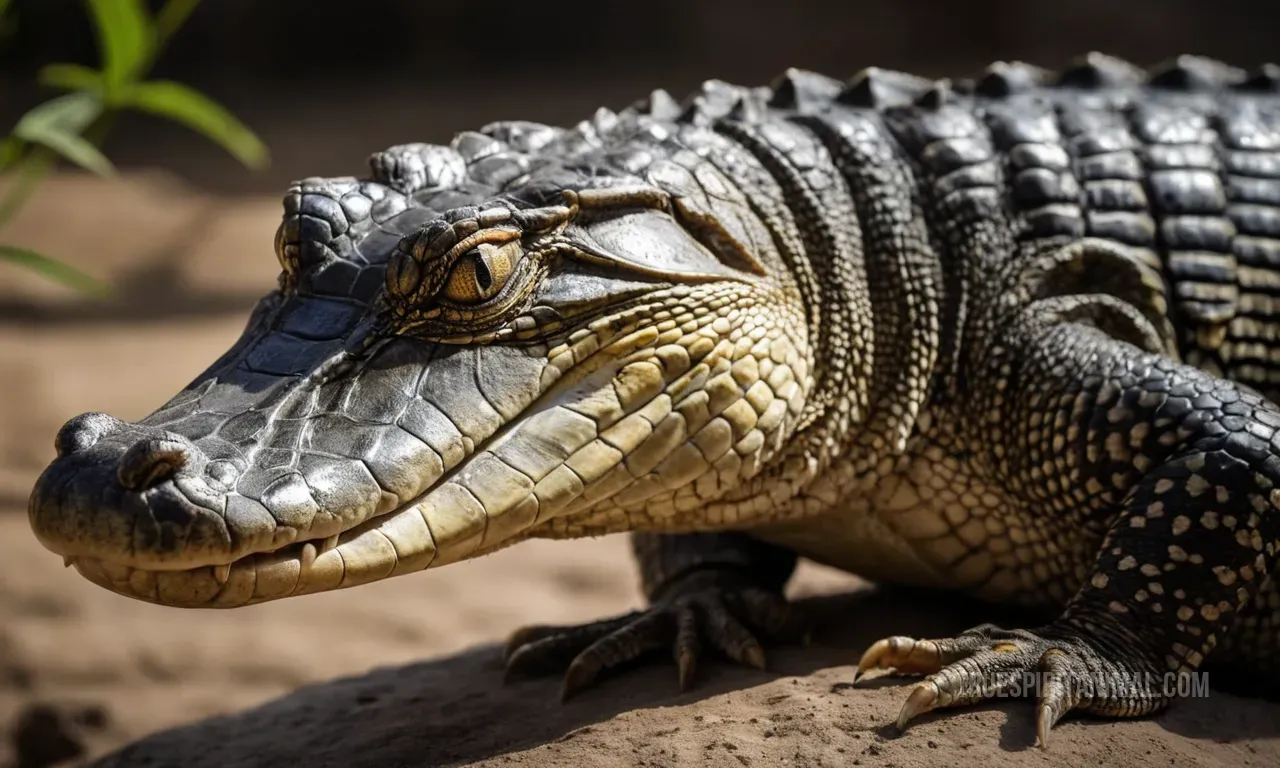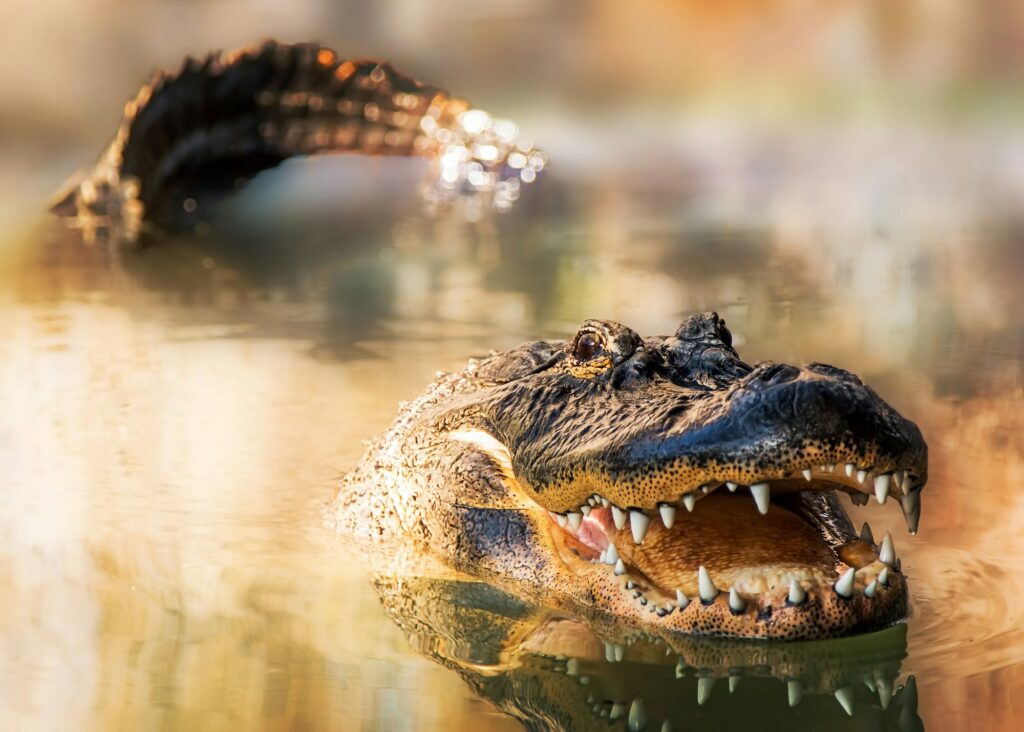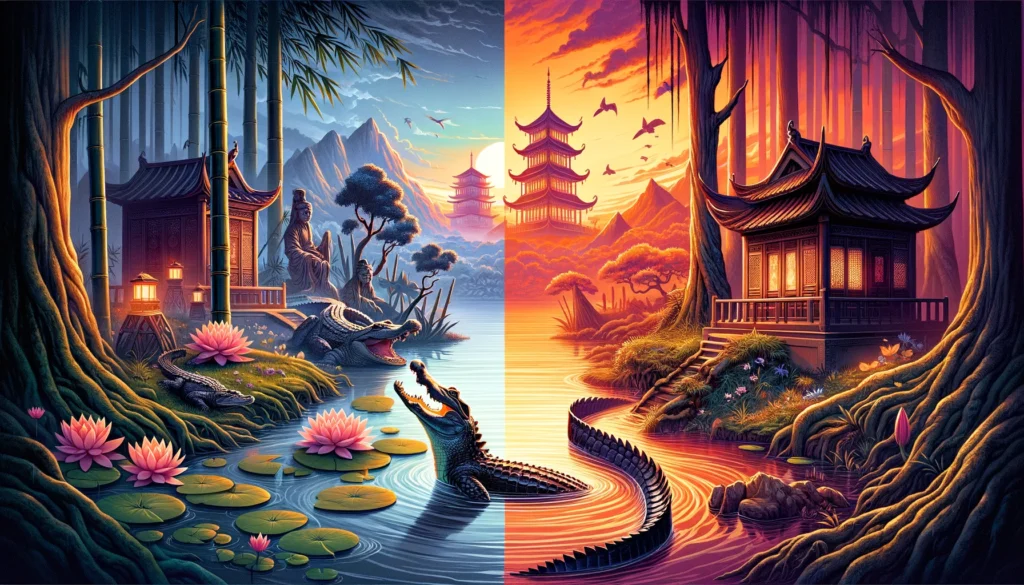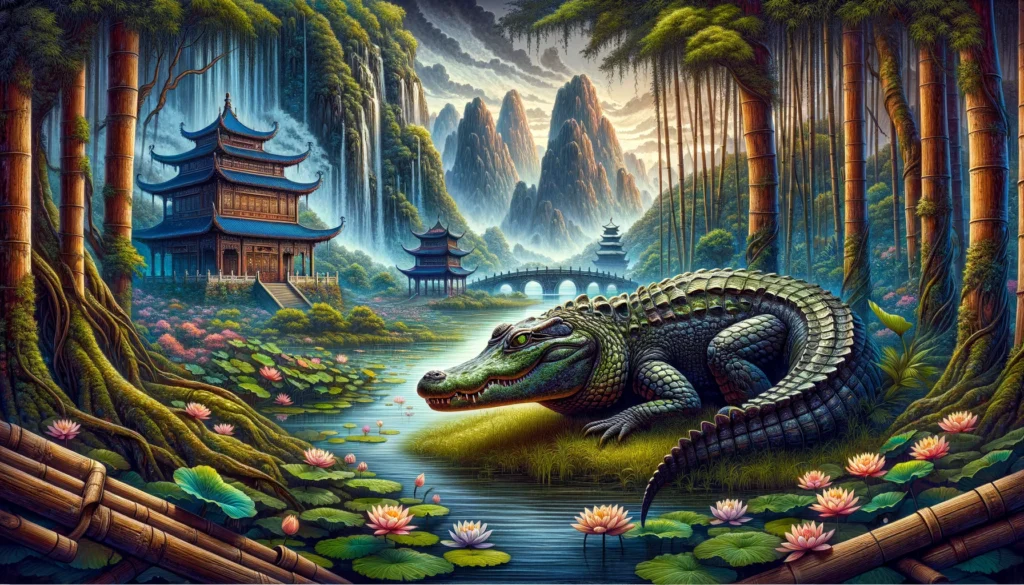Chinese Alligator Symbolism and Meaning

The Chinese alligator is a powerful symbol in Chinese culture and mythology. This ancient reptile is believed to possess great strength, primal energy, and ancient wisdom.
In this article, we’ll explore the symbolic meaning of the Chinese alligator, including its role as a totem animal, connections to the Chinese dragon, and more. We’ll also compare Chinese alligator symbolism to that of the American alligator and crocodile symbolism in other cultures.
What Does the Chinese Alligator Symbolize in Culture and Mythology?
The Chinese alligator (Alligator sinensis), also known as the Yangtze alligator, is an important part of Chinese culture and mythology. This freshwater reptile is native to the Yangtze River basin and is one of the most endangered species on the planet.
In Chinese mythology, the alligator is believed to possess great primordial power, strength, and longevity. It is seen as a representation of the life-giving properties of water combined with the primal energies of the earth.
The Chinese alligator is also associated with discretion, stealth, and patience. Its ability to lay camouflaged and wait patiently for long periods serves as a reminder to exercise discernment and self-control in pursuit of our goals.
Overall, the alligator symbolizes strength, power, energy, discretion, and ancient wisdom in Chinese culture. It is a powerful totem animal believed to lend its attributes to those who call upon it.
Exploring the Role of the Alligator in Chinese Culture

The Chinese alligator has played an important role in Chinese culture for thousands of years. Ancient rock carvings and decorations depicting alligators have been found dating back over 5,000 years.
In ancient times, the Chinese valued the alligator for its meat and medicinal properties. Alligator bones and teeth were used in traditional Chinese medicine practices. Marco Polo even wrote of merchants selling alligators in 13th century Hangzhou.
The Chinese alligator is so intertwined with Chinese identity that it is featured prominently in creation myths from southern China. One myth claims the first alligator emerged from the Yangtze River thousands of years ago with the head of a man.
Today, the Chinese alligator is a powerful symbol of Chinese culture and mythology. It embodies the Chinese reverence for longevity as one of the oldest living species on Earth. The alligator’s endangerment has become a sobering symbol of habitat destruction in China.
Comparing Chinese Alligator Symbolism to the American Alligator

While the American alligator is prevalent in the southern United States, the Chinese alligator is critically endangered with less than 150 believed to be left in the wild. Yet both play powerful symbolic roles in the cultures and mythologies of their native lands.
In the United States, the American alligator is often seen as a symbol of the Southeast. It represents the mystery and untamed wilderness found in swamps and bayous where alligators dwell. The alligator is also viewed as a survivor and adapter – a fitting totem for the resilience and fortitude of Southern culture.
Comparatively, the Chinese alligator is more intertwined with ancient mythology tied to water and the earth’s primordial energies. It has deeper connections to spiritual concepts like longevity, discretion, and wisdom – attributes more revered in Chinese culture.
So while both alligators represent strength, power and stealth, the Chinese alligator bears the weight of Chinese identity and ancient mysticism in a way the American alligator does not. Their endangerment has only heightened their cultural meaning.
The Symbolic Association Between the Chinese Alligator and the Chinese Dragon
The Chinese alligator is closely associated with another prominent symbol in Chinese culture – the Chinese dragon.
In Chinese mythology, it is believed the Chinese dragon evolved from more primitive reptiles like crocodiles and alligators. The dragon is thought to have acquired magical attributes and powers through centuries of spiritual cultivation and self-improvement.
Thus the Chinese alligator is seen as the primal, earthly form of the sacred Chinese dragon. The alligator represents the untamed natural state, while the dragon represents the cultural achievements attainable through dedication and betterment of the self.
Yet both symbols share attributes like strength, longevity, and energy. This is why Chinese art often depicts dragons and alligators together – such as the dragon gates with guardian alligators found at ancient Chinese sites.
Their intertwined symbolism reminds us we all contain both primal instincts as well as higher spiritual potential. With self-cultivation, our energy can transform from untamed to sacred.
How is the Chinese Alligator Viewed as a Totem or Power Animal?

The Chinese alligator is a powerful totem and animal guide for those seeking to channel its symbolic strengths into their own lives.
As a totem, the Chinese alligator lends us its attributes of strength, longevity, patience, and discretion. When the alligator comes to you as a spirit guide, it is often a call to stand strong while remaining aligned with your higher purpose – just as the alligator moves steadily through the water yet remains camouflaged.
The alligator totem reminds us to move through life with tenacity, wisdom, and emotional balance. It calls us to tap into our own inner wells of strength and patience as we work toward self-mastery.
In this way, Chinese alligator symbolism parallels the attributes of the Chinese dragon. Its ancient energy stirs our own primal life force.
Understanding the Chinese Alligator as a Totem Animal
As a totem animal, the Chinese alligator represents incredible survival instincts, emotional balance, and alignment with purpose.
The Yangtze alligator is a master of stealth and patience. It can lay still for days, perfectly camouflaged, biding its time to strike. As a totem, the alligator reminds us to move through life deliberately, never sacrificing personal integrity or a higher purpose for immediate gain.
Alligators are also symbols of emotional balance and resilience. Despite their environment and circumstances, they maintain equilibrium and adapt to challenges. The alligator totem teaches us to remain calm and steadfast as we navigate change.
Above all, the Chinese alligator is a survivor – having lived on this planet in some form for 200 million years. Its ancient energy is the stuff of legends. As a spirit animal, the alligator connects us to the most primal and potent life force on Earth.
When the alligator comes to you, it is time to tap into your inner wells of strength, wisdom, and purpose. Stand tall, move with intention, and never compromise who you are.
The Significance of the Alligator Totem in Spiritual Practices
The Chinese alligator is a powerful totem and symbol used in various spiritual practices. Shamans may call upon the alligator for protection, clarity, or to stimulate kundalini energy.
In Chinese mythology, it is believed alligators possess great primordial power – the pure life force that flows through plants, animals, and people. This is called yuan qi or primal chi, and meditating with alligator symbolism can help activate this base energy.
The stealth and camouflage of alligators can help stimulate more subtle energetic practices too. Alligator symbolism teaches us to move through the world with discretion and emotional balance – never compromising personal truth. By inspiring these attributes, the alligator helps align energy with purpose.
Dreaming of or envisioning alligators can also activate deeper spiritual insights. The fearsome nature and sharp teeth of alligators prompt our subconscious to surface suppressed issues or emotions needing resolution. Their symbolism calls for honest self-reflection and spiritual growth.
Overall, the Chinese alligator is valued as a spiritual guide for stimulating primal energy, self-mastery, emotional balance, and the setting of healthy boundaries. By inspiring its attributes, this totem reptile becomes a valuable ally on the spiritual path.
The Spiritual Meaning Behind Alligator Dreams and Visions
Throughout history, shamans, mystics and healers have interpreted the appearance of alligators in dreams and visions as carrying profound spiritual meaning.
According to ancient Chinese dream interpretation, seeing an alligator in dreams signals there are primal energies or unresolved issues that require attention. The alligator prompts our subconscious mind to surface suppressed problems so they can finally be healed.
Dreaming of a large or aggressive alligator often represents an intense emotional struggle we are facing. The alligator’s presence is a call to directly face and resolve the emotional conflict, rather than avoiding it out of fear. Finding resolution will grant renewed strength and clarity.
Alternatively, a calm alligator in dreams is considered very auspicious in Chinese culture. This represents emotional balance and alignment with one’s highest purpose. The alligator provides spiritual protection to stay focused and move steadily towards self-actualization.
Seeing alligators in visions or shamanic journeys also carries spiritual significance. The alligator is viewed as an ancient power animal that can awaken our own inner power to manifest positive change. Its ferocity inspires courage, while its primordial energy awakens healing and creativity.
Deciphering the Message: Dreaming of an Alligator
To see an alligator in your dream represents a strong and powerful part of yourself that you may be neglecting or overlooking. It may also suggest a primal instinct stirring within.
An alligator dream is often a call to action – particularly regarding goals you may be afraid to pursue or emotions you have suppressed. The fearsome nature of alligators prompts your subconscious to confront that which has been avoided.
If the alligator is threatening in your dream, this likely points to intense emotions you have yet to face – such as anger, grief, jealousy or resentment. Your dream is signaling it is time to honestly process these feelings so they no longer control you unconsciously. Finding resolution will restore emotional balance.
If you dream of a calm, still alligator, this is very fortuitous. It suggests security in your emotional foundations and stability in pursuing your purpose. An alligator at peace symbolizes you are in alignment with your highest self.
Dreaming of alligators may also activate the reptilian, primal areas of your brain related to instincts and reflexes. Your dream state is seeking to unlock these more unconscious parts of self and integrate them into your whole being.
Visions of Alligators: Symbolic Interpretations and Spiritual Insights
Seeing alligators in visions or shamanic journeys often carries profound symbolic meaning tied to spiritual growth and personal development.
Typically alligators represent the ability to access primal energy states and the courage to wield that power wisely. Their presence calls us to tap into our instincts and deepest wisdom to consciously create the reality we seek.
If the alligator is threatening in your vision, this signals it is time for strong personal boundaries to be set. The ferocity of alligators reminds us that we must first face our inner demons before achieving empowered action in the world. Find self-mastery first.
Yet if the alligator is calm or even friendly in your vision, this indicates you have sufficiently mastered the primal areas of self and can now activate high-level manifestation. You have balanced instinct with wisdom and can achieve anything.
Ultimately alligator visions prompt us to reach our highest potential by facing our deepest fears. Their presence is one of great power – signaling we too can achieve empowerment if we have the courage to transform ourselves at the spiritual level first.
The alligator is a guide to realizing our full capability to create and accomplish. But we must commit to the inner work necessary to responsibly wield such power.
Comparative Symbolism: Chinese Alligator Vs. Crocodile in Different Cultures
While alligators and crocodiles may look similar, their symbolic meanings differ across cultures. By comparing Chinese alligator symbolism to crocodile symbolism, important nuances emerge.
In ancient Egyptian culture, the crocodile represents the primal life force energy itself. The crocodile god Sobek personified this concept as fertility, protection and the Nile river’s regeneration.
In Mesoamerica, cultures like the Aztec and Maya developed crocodile symbols related to the earth, fertility, water and the planet Venus. Crocodiles were viewed as creatures straddling multiple realms.
In Chinese culture, the alligator possesses similar attributes but more symbolic complexity. While representing primal earth energies, alligators also signify emotional balance, discretion in using power, and the ability to remain camouflaged.
Additionally, the Chinese alligator is tied to the spiritual ascension from reptile to dragon – earthly knowledge evolving into sacred wisdom over time. This concept is unique to Chinese culture.
While both reptiles represent the powerful energies of nature’s elements, the Chinese alligator also epitomizes cultivating wisdom and responsibility once such primal power is activated. This distinguishes it from crocodile symbolism in other cultures.
Chinese Alligator and Crocodile Symbolism: A Detailed Comparison
Alligators and crocodiles share many common symbolic attributes, being apex aquatic reptiles that have barely changed since prehistoric times. Both represent qualities like longevity, stealth, primal power and mastery of their watery domains.
However, a key difference is crocodiles are more associated with the waters themselves – rivers, lakes, oceans – while alligators tend to represent the earthly mud and swamps from which they emerge.
Additionally, Chinese alligators possess deeper cultural complexity due to being intertwined with Chinese identity for thousands of years. They have a revered place in origin myths tied to the sacred Chinese dragon and the development of Chinese civilization.
Conservation Status: What the Plight of the Chinese Alligator Tells Us
The Chinese alligator is one of the most critically endangered species on Earth, with population numbers estimated between 120-150 in the wild. Their situation speaks volumes about habitat destruction and environmental neglect in China over recent decades.
As one of the oldest living species spanning 200 million years, the demise of the Chinese alligator would represent the extinction of truly ancient wisdom. Its plight has become a sobering wake-up call regarding impacts of “progress” on wildlife and climate.
Efforts to revive the wild Chinese alligator population reveal a commitment by a new generation of Chinese conservationists to rectify past mistakes. This willingness to save an endangered native species signals deeper realizations about sustainability.
In essence, the Chinese alligator has become a bellwether for economic development at the expense of environment in modern China. Its conservation status urges more balance is needed between progress and preservation before it’s too late.
The Impact of Endangerment on the Symbolism of the Chinese Alligator
As a species that has survived for 200 million years, the Chinese alligator was always revered for its longevity. But with estimates of under 150 alligators remaining in the wild, its powerful new symbolism relates to human-caused habitat destruction.
The Chinese alligator once thrived throughout the Yangtze River basin for millennia, playing an integral role in wetland ecosystems. But breakneck industrialization over recent decades led to extensive habitat loss and poaching.
Now the alligator’s spiraling path towards extinction in the wild reveals the painful impacts of China’s unchecked modernization on the natural world. What was once a sacred symbol of prosperity and longevity is now a sobering reminder of development’s unintended consequences.
Yet this makes efforts to save the Chinese alligator even more meaningful. Its return from the brink emphasizes that our unwise actions can still be reversed if we have the will to change. In this way, the alligator transforms into a symbol of hope – that humanity and nature need not be mutually exclusive after all.
Efforts to Preserve the Chinese Alligator: A Symbol of Hope
In the early 2000s, an extensive survey by Chinese herpetologist Dr. John Thorbjarnarson confirmed fewer than 150 Chinese alligators remained in the wild – mostly in small, isolated pockets of habitat. Alarmed by how rapidly the species was disappearing, Thorbjarnarson’s team launched efforts to protect the remaining wild alligators while also breeding captive populations.
These projects provided guarded optimism that the now-Critically Endangered Chinese alligator could be brought back from the edge of extinction. The Anhui Research Center for Chinese Alligator Reproduction and Chinese Alligator Nature Reserve were established to facilitate this goal. Both wild and captive breeding populations became part of a unified conservation strategy.
While much work remains to restore self-sustaining wild populations, over 10,000 Chinese alligators now live in protected sanctuaries – preventing the species’ complete extinction. No longer a symbol only of the impacts of rampant development, the Chinese alligator has transformed into a symbol of how committed conservation science can still reverse ecological decline.
This offers wider hope that humanity can learn to progress in harmony with nature rather than at its expense. The Chinese alligator reminds us that our compassion and willingness to change course can redeem even our gravest mistakes against the planet.
Recent Insights and Posts on Chinese Alligator Symbolism and Conservation
As conservation efforts gain momentum, researchers continue gaining new insights into the behavior and nature of Chinese alligators. This expands the cultural mythos and symbolism surrounding this ancient, revered reptile.
Recent studies revealed Chinese alligators employ advanced cooperative hunting techniques not seen in any other crocodilians. Researchers posit this social behavior and adaptation to their habitats has enabled Chinese alligators to survive for so long compared to other ancestral crocodilians.
In this way, the cultural symbolism of Chinese alligators continues evolving – from not just representing primal strength but also intelligence and social cooperation symbolizing the Chinese values of collective prosperity and unity.
Furthermore, recent updates show the Anhui sanctuary has had success with reintroduced alligators breeding, suggesting revival of the wild population remains possible. As researchers learn more about sustaining ecosystems for the alligator’s survival, the symbol of the Chinese alligator as an icon of environmental redemption only strengthens.
Latest Research and Symbolic Interpretations of the Chinese Alligator
Ongoing research is revealing intriguing new dimensions to the behavior and nature of Chinese alligators – sparking reinterpretations of their cultural symbolism.
Recent studies indicate Chinese alligators employ sophisticated cooperative hunting strategies, dispatching large waterfowl too big for a single gator. This level of coordination and social collaboration is very rare among reptiles.
Additionally, new evidence shows that after mating, male Chinese alligators remain with females for an unusually long 5 years to help guard and protect hatchlings – the longest paternal care documented in any crocodilian.
The symbolism of the Chinese alligator is expanding to represent higher order traits like social cooperation, adaptation, and dedicated family bonds pairing strength with nurturing. This mirrors cherished Chinese cultural values of community, ingenuity, prosperity, and unity.
As researchers uncover more fascinating facets of this ancient species, their rich symbolic meaning continues to evolve – no longer signifying just primal ferocity but higher virtues working collectively towards survival and harmony.
Conservation Stories: Progress in Saving the Endangered Chinese Alligator
While fewer than 150 Chinese alligators remain in the wild, captive breeding and reintroduction efforts are showing promising signs of progress.
A prime example is the success of the Anhui Research Center for Chinese Alligator Reproduction established in 2001. Starting with just 34 animals, their captive population now exceeds 10,000 alligators raised across six protected breeding sanctuaries.
In a major breakthrough, babies born from reintroduced alligators were recorded living naturally in the protected wild habitats in recent years – evidence of a new generation thriving. Fifty-five alligators have now been released back into marshlands under close monitoring.
Stories like these replacing narratives of endangerment with redemption are transforming the Chinese alligator into a global icon of how committed environmental science can still turn back extinction.
More broadly, the plight of the Chinese alligator has become a catalyst for wider ecological awareness and sustainability initiatives across China. Its revival has become a symbol of hope – that our unwise actions need not be permanent if we work quickly to restore balance between civilization development and conservation.
The Chinese alligator will remain an integral part of the culture. But with continued progress safeguarding its future, its shifting symbolism tells a larger story of a nation owning past mistakes and charting a new course towards harmonious prosperity.
Final Thought
The Chinese alligator has endured as a powerful symbol of longevity, strength, discretion and emotional balance in Chinese culture for millennia. But in recent history, its spiraling path towards extinction served as a wake-up call regarding the intense environmental impacts of China’s rapid modernization.
Fortunately, conservation efforts sparked by passion to save this iconic species are showing promising signs of revival. The tenacity of Chinese alligators is transforming them into inspiring symbols of how humanity’s compassion and willingness to change course can still redeem even our gravest mistakes against nature.
If populations can rebound sufficiently to be stable again in their native wetlands, the alligator’s symbolism will come full circle – once again representing prosperity, unity and the sacred balance between civilization and wilderness for future generations.
Their continued presence is a reminder that by learning from the wisdom of the past while also innovating new paths forward, China can achieve harmonious progress where economic development enriches human potential and environmental health simultaneously.
In this way, the Chinese alligator remains a powerful totem as China progresses into a new era emphasizing sustainability – still representing strength and longevity but now also hope, redemption and the promise of balance restored.




